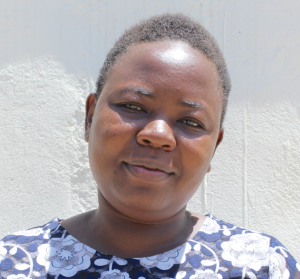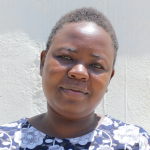It was a bright and sunny morning the day we most recently visited Sambaka Village. We first learned about Sambaka Village's main water source, Sambaka Spring, during the training at nearby Wasike Spring. It was there that a Sambaka community member met our team of field officers and requested them to visit their unprotected spring, and we have been working with Sambaka Village ever since.
Sambaka Spring has enough water for the 350 community members who depend on it, but it is not safe for drinking purposes due to its openness to contamination. The spring is not very far from homesteads and the spring is accessible to everyone. The way leading to the spring is not that busy, and both the old and the young can access water without any problem.
The community members come with containers that are often dirty to draw water, which contributes to further contamination. Community members have to get inside the spring and dip their containers into the water, some using smaller jugs or cups to fill bigger containers. This stirs up the mud and makes the water murky.
Community members have suffered for a long time due to the spring not being protected, with typhoid as the main waterborne disease making people sick.
“Personally I have had several challenges, [as] we have spent a lot of money and time [on] treating our children [from waterborne illnesses]," said Syphorose Mamati, a farmer and mother who lives in the village.
"I will be so grateful if our spring will be protected."
In this community, the majority of people use pit latrines with superstructures made of different materials, including mud walls and iron sheets, dried grasses, or anything else that will provide privacy. There is water around some of the latrines for handwashing using a tippy tap. Most community members expressed their stress, however, that they had never had any information shared with them regarding health education, hygiene, or maintenance of their latrines.
"We as the people of Sambaka community have suffered a lot due to lack of access to clean drinking water and sanitation," said Denial Major, a farmer and father in Samabaka.
"Addressing sanitation challenges here will improve livelihoods and our life will not be the same again."
Sambaka community is a traditional rural settlement whose farm holdings have gradually decreased due to the subdivision of land. The community is very peaceful and unified, as evidenced by the calls we would get from neighbors whose own water source was protected, but who were worried about their neighbors who were still dependent on unprotected Sambaka Spring.
This location experiences both short and long periods of rain, unlike the rest of the area. This has made the area very green in terms of vegetation. Most families are small scale farmers, growing maize, sugarcane, beans, and sweet potatoes. Hence, families' food provision is at the core of their activities. Some of the buildings in the village are mud-walled while others are made of brick walls with iron sheet roof and separate, grass-thatched kitchens.
A typical day here starts at 5:00 am when most people wake up to prepare their children to go to school. Then at around 6:30 am the adults proceed to their farms until 10:00 am, when women come back home to do domestic chores like cleaning, fetching water, cooking, and grazing their cattle. At around 3:30 pm at the start of sunset, the women start preparing for dinner while men will walk to the market to go and socialize with other men. After dinner, women will sit around the table for discussions and prayers. The men come home anytime between 9:00 pm to 10:30 pm and the women are expected to still be awake to serve them food. After that, everyone can now retire to bed.
What we can do:
Spring Protection
Protecting the spring will help provide access to cleaner and safer water. Construction will keep surface runoff and other contaminants out of the water. With the community’s high involvement in the process, there should be a good sense of responsibility and ownership for the new clean water source.
Fetching water is predominantly a task carried out by women and young girls. In Sambaka as in so many places in this region, this is especially true as more value is put on boys' futures, so they end up being the ones who continue in school. Girls are therefore left at home and are responsible for often doing as many chores as adult women. Protecting the spring and offering training and support will, therefore, help empower the female members of the community by freeing up more of their time and energy to engage and invest in income-generating activities.
Training
Community members will attend hygiene and sanitation training for at least 2 days. This training will ensure participants have the knowledge they need about healthy practices and their importance. The facilitator plans to use Participatory Hygiene and Sanitation Transformation (PHAST), Community-Led Total Sanitation (CLTS), Asset-Based Community Development (ABCD), group discussions, handouts, and demonstrations at the spring. One of the most important topics we plan to cover is the handling, storage, and treatment of water. Having a clean water source will be extremely helpful, but it is useless if water gets contaminated by the time it is consumed. We will also emphasize the importance of handwashing.
Training will result in the formation of a committee that will oversee the operations and maintenance of the spring. They will enforce proper behavior around the spring and delegate tasks that will help preserve the site, such as building a fence and digging proper drainage channels. The fence will keep out destructive animals, and the drainage will keep the area’s mosquito population at a minimum.
Sanitation Platforms
On the final day of training, participants will select 5 families that should benefit from new concrete latrine floors. Training will inform the community and selected families on what they need to contribute to make this project a success. They must mobilize locally available materials, including bricks, clean sand, and gravel. The 5 families chosen for sanitation platforms must prepare by sinking a pit for the sanitation platforms to be placed over. All community members must work together to make sure that accommodations and food are always provided for the work teams.

 Protected Spring
Protected Spring
 Rehabilitation Project
Rehabilitation Project














































